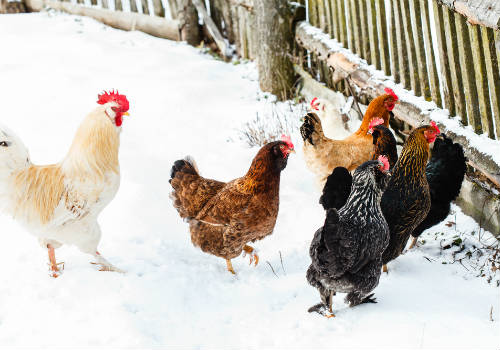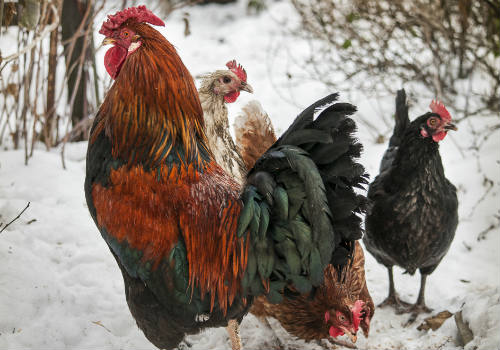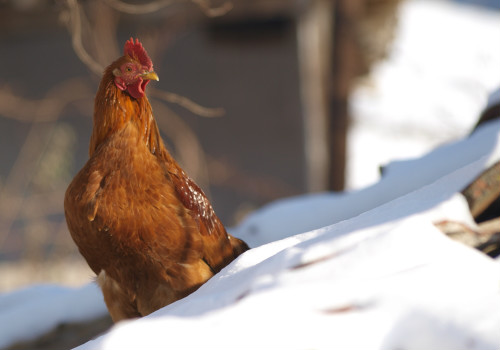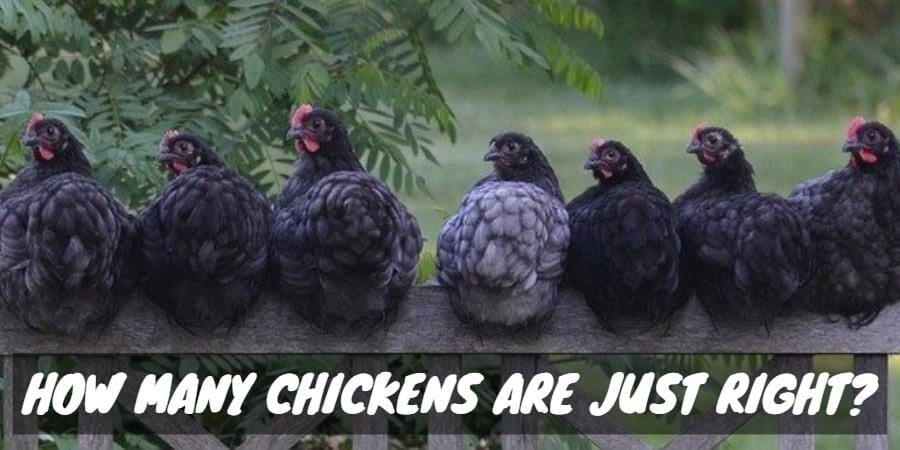This article is going to focus on answering the question, “How cold is too cold for my chickens?” We’ll also discuss how you should prepare for the winter months so your chickens keep warm.
Do My Chickens Need a Heat Lamp in the Winter?
Chickens can actually deal quite well with cold temperatures. Their bodies are equipped with a plumage (their feathers) which is comprised of several layers of protection to trap warm air near their skin.
If you look closely at molting chickens, you’ll notice that they have different types of feathers, which help to form several insulating layers.
They are:
- Contoured plumage feathers, which means the feathers are shaped to the bird’s body to offer increased warmth
- Wispy feathers, which are closest to the skin; they’re fluffy so they trap warm air against the chicken’s body like a cozy blanket
- And a combination of contoured and wispy feathers

Chickens have an exceptionally high metabolic rate that also works hard to keep them warm. And by high, I mean their heart rate can reach 400 beats per minute. This makes them extremely resistant to cold temperatures.
Simply put, chickens can survive in temperatures well below freezing, but I wouldn’t overdo it.
Also, keep in mind that chickens living together in a coop will generate their own heat, so when the outside temperature drops, your coop will be a little warmer.
There are a lot of people living in extremely cold climates like Alaska that keep chickens all year long without any added heat. As long as your coop is weatherproof, you’ll likely be okay. But surviving and thriving are not the same thing. We want our chickens to thrive since it’s our responsibility to care for them.
Preparing Chickens for Winter
Now that we know our chickens can survive in extremely low temperatures, it’s time to make sure they can thrive in these same climates. Here is a quick look at some essentials that you’ll need to stock up for winter.
Chicken Feed: Make sure you have enough to last for up to two full weeks. Scratch should also be included in this category.
Water: Fill up several plastic containers with water just in case something happens and you can’t access it for a few days. The rule of thumb is that one gallon of water will hydrate eight chickens for one day. Make sure you have enough water stores for up to three days.
Balm or Petroleum Jelly: You need a large can of this in order to protect wattles and combs.
Bedding: Most people use straw but you can use anything you want. Chickens hate walking on snow so give them comfortable bedding.
Feeding Chickens in Winter

First off, you can feed chickens greens or fruits once a week as a treat, but this is not always cost-efficient. It does, however, keep them happy.
On a total aside: a friend of mine persuaded his local supermarket manager to give him the store’s damaged (and expiring) fruits and vegetables. Although they weren’t good for humans, they were a perfect treat for chickens. If your local manager won’t do the same for you, perhaps he’d/she’d be willing to give you a discount.
Treats are one thing, but I’d suggest you maintain enough feed for two weeks just in case of an emergency.
Each evening, I like to throw some chicken scratch or corn out because it helps keep my birds’ digestive systems working through the night. This adds warmth to their body.
Just be moderate with this. Try aiming for two beaks-full per chicken.
Watering Chickens in Winter
Water is a huge problem during winter unless you’ve invested in heated drinkers. But those without this luxury are going to struggle. You will have to make three or four trips per day to make sure that your birds are properly hydrated because it doesn’t take long for the water to start freezing.
You can also try using heavy plastic bowls so that the ice takes longer to form. When it does, it’s also easier to remove the ice from a plastic bowl.
Some experts also suggest giving your chickens Apple Cider Vinegar and vitamin powder at least once per week.
Keep Your Chickens Dry and Warm in Winter
This is an essential step. You cannot maintain a damp coop during the colder months nor should their be uncomfortable drafts that could cool your chickens during the night. Chickens require a safe place that they can turn to when the wind is blowing or during cold precipitation.
While your coop should be well ventilated, the air shouldn’t blow directly onto your birds.
If your coop happens to have an excessive draft, try wrapping it in Tyvek or a cheaper tar paper to see if it eliminates it. It only takes a few hours, and it’ll provide safety (and comfort!) for your birds.
Vents are placed above the heads of your chickens so that moist air can move out of the coop. When chickens sleep, they release moisture into the air surrounding them. This moisture is not healthy for the flock, so it needs a place to escape. If it is allowed to build up, then it can turn into mold spores that will cause the chickens to get sick.
Keeping the area protected from rainwater is just as important. When birds get soaked, their feathers cannot act as intended. The bird will get sick and could even die from hypothermia.
Should I Put a Heat Lamp in My Chicken Coop?
This is a common question every winter. It really just boils down to personal preference. Chickens do not require extra heating until the temperature drops down into the single digits. So in most cases, the answer is going to be no. Here’s why:
- Chickens are coated in feathers that keep them warm even when the temperature gets down in the teens.
- Heat lamps are a fire hazard unless they are installed correctly.
- Too much heat is not healthy for chickens. They will also become too dependent on it so they will not be able to withstand the cold as much.

Chickens will actually heat up a coop themselves. Each one is about the equivalent of a 10-watt bulb! When they’re piled together they will generate a lot of heat.
If you still think that your coop requires heat, please avoid heat lamps. Use something like a small oil filled radiator instead. There are so many stories of heat lamps causing fires that it’s not worth the risk.
Make sure you add bedding made of straw because it will also help keep chickens warm. This is a cheap option that works wonders.
If you are raising free-range chickens, then you should make sure there is straw laid out for your birds. They will not walk on snow. Plus, they will need a place to hide from hawks and other predators – not to mention places to stay warm. Predators are especially hungry during winter months since food is scarce. They will be more aggressive so make sure your birds have a place to hide.
How to Use the Deep Litter Method
The deep litter method is a layer of organic matter like pine shavings that are placed over the floor of your chicken coop. This is an amazing way to manage the litter of your flock while also providing additional insulation during the cold winter months.
Rather than being forced to clean waste that your birds accumulate, all you’ll need to do is stir up the litter with a rake. Your flock will naturally do the rest.
When you do this the right way — by topping with pine shavings — the litter will form compost that is inviting to healthy microbes. These will eat away the unhealthy bacteria of the chicken’s waste. It also insulates the coop even further, keeping it warmer.
Use Sunlight to Trap Heat for Night
You should be using as much natural heat as possible to help keep the costs down on your chickens. So using the sun to keep your coops warm for longer into the night is a really neat trick. Install a few well-insulated windows, so the sunlight is trapped inside. Then it will stay warm for longer once the sun sets.
Thermal mass is also important for this method. Simply put, it’s the measure of how much heat-absorbing materials you have inside of the coop. The more heat that can be absorbed before nightfall, the longer it will stay warm. Compost, stone, and concrete have a high thermal mass rating.
Add a Sunroom
Many owners fall prey to the temptation to keep their chickens locked away completely from the cold, but they will actually benefit more if you install a sunroom. It gives them more space to move around and provides fresh air. To do this, build a greenhouse-style room for your coop and cover it with clear plastic to keep it sheltered from the rain.
Chickens will move to this room when they are uncomfortable in the normal areas.
The Bottom Line: the Biggest Threats to Your Chickens
Only extremely cold weather is dangerous to your chickens because they have an uncanny ability to adapt to low temperatures. The biggest threats are their drinking water turning to ice and nearby predators, which applies mostly to free-range chickens. You’ll need to take preventative measures to protect your birds from these two factors if you’d like them to live long and happy lives.




